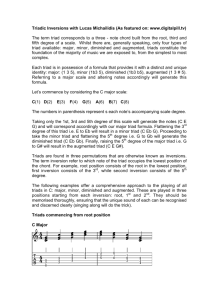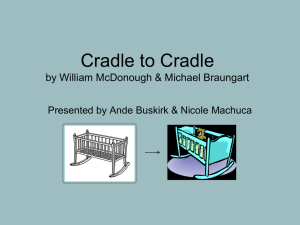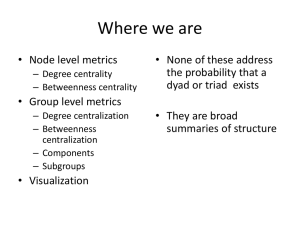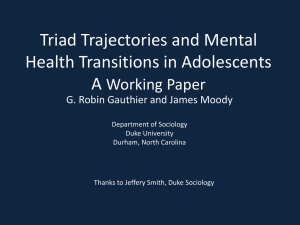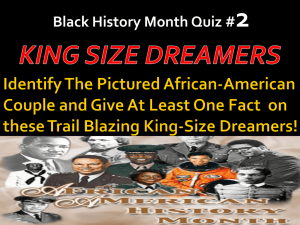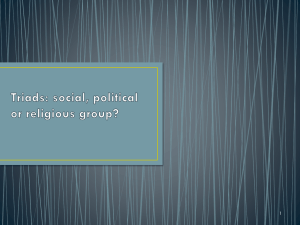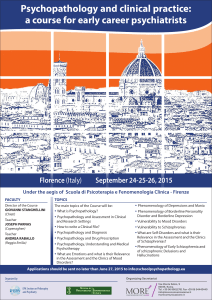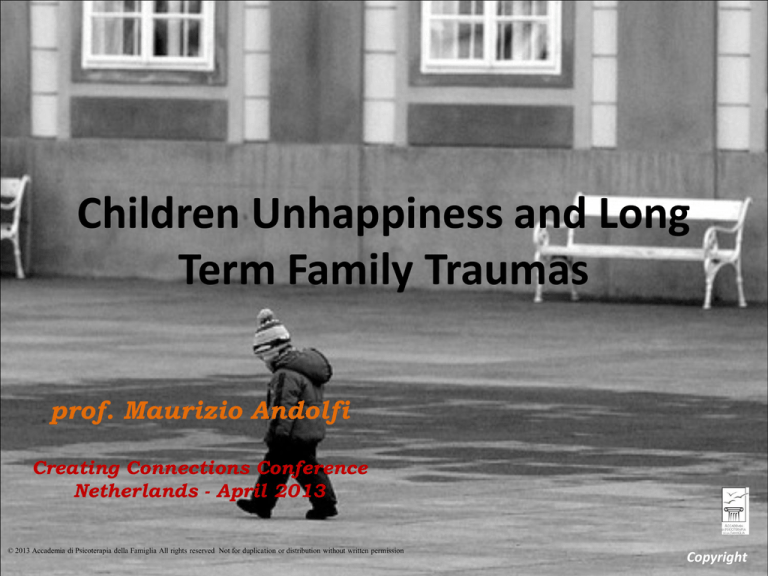
Children Unhappiness and Long
Term Family Traumas
prof. Maurizio Andolfi
Creating Connections Conference
Netherlands - April 2013
© 2013 Accademia di Psicoterapia della Famiglia All rights reserved Not for duplication or distribution without written permission
Copyright
From the dyad
to the triad:
from child psychiatry to family therapy
a 45 years long journey: personal and
professional transformations
A few guide principles for
systemic - relational interventions
• Every child problem is a family problem
• Every child has his/her own voice and is a subject of
competence.
• Children need fathers too in their growing (in intact as well as
in step or single parents families).
• Fathers are still fathers, regardless of their good or bad
behavior.
• The primary triangle is the basic unit of observation and the
main therapeutic resource.
• A tri-generational perspective is very useful in evaluating
family functioning and individual psychopathology
The baby and the triad
How research can enrich therapeutic interventions
and how clinicians can contribute to research
• Is the infant capable to experience the triad as a whole?
• What are the processes by which an infant might grasp
triangular interactions between him/herself and the two
parents?
• How might the infant communicate with both at the same
time rather than sequentially, in dyads?
• How would the infant construct triangular representations
as a base for a participation in the family’s collective intersubjectivity?
Collective inter-subjectivity
• Is a motivational system
separated from the
attachment system and
plays an important role in
the survival of the species.
Human beings don’t survive
without groups, family,
team, tribe.
Infants have to be born to
deal with a variety of
caretakers contexts
Daniel Stern
The triad is not made
of separated dyads
seen sequentially, but
rather of one
threesome: all three
characters could be
held in mind
simultaneously
Elyzabeth Fivaz’s studies on the primary triangle: the
Lausanne trilogue play paradigm
The four interactive scenarios in each triad of infants and parents
The mastery of previous four configurations
triangular system provides the child with the
capacity to view and experience his position as
third party in relation to his parent’s couple in a
broader context.
Fundamental parameters
•
Family alliance
is the degree of coordination that the
family members attain in working jointly
towards realizing a task (in the LTP the goal
is to reach moments of playful affective communication)
• Intergenerational boundaries
When the boundary marked by the parents in
relation to their child is clear and flexible, the
development of the infant’s triangular capacities
is facilitated.
Daniel Stern coined a neologism clusion, to describe this positive form of
triadic interaction.
Intergenerational boundaries
distorted
When the boundary is too rigid or too permeable, the
development of the infant’s capacities are distorted:
1. Boundary too rigid leading to
the exclusion of the child
1. Boundary too permeable leading to
his inclusion in the couple unit
Same principles can be applied to clinical work with families
Systemic and intergenerational
theories on the triad
Authors and pioneers of family therapy like Nathan
Ackerman, Murray Bowen, Albert Scheflen, Jay Haley,
Salvador Minuchin, Jim Framo, Carl Whitaker, Froma
Walsh, Lynn Hoffmann and in Italy Mara Palazzoli
Selvini and Maurizio Andolfi among many others
have been describing:
the triangle as the basic unit of observation of
family relationships and studying the quality of
intergenerational boundaries inside the family life
cycle.
The triangle as the basic unit of
observation
The primary triangle is a model of observation of family
relationships and child development.
Triadic interactions are the essence of human
communication and social belonging.
The quality of triadic interactions defines healthy growth
or the emergence of psychopathology.
Healthy growth
Circularity and flexibility in triadic interactions: no
inclusion, no exclusion of one member of the triad
A
C
Clear boundaries between parents’ sub-system and
children sub-system
B
The emergence of psychopathology: different
forms of family dysfunctional triads
• Ackerman: the child as a family scapegoat.
Child blamed for parents’ faults
•
Bowen: oversaturated (pathological) triangles. When a
triangle’s emotional response to a stressful
situation is overwhelming, while other triads are
more dormant
• Minuchin: rigid triads. When a child is often used
to detour the couple’s conflict
The emergence of psychopathology: different
forms of family dysfunctional triads
• Haley: perverted triads. When there is an implicit coalition
between a parent and the child against the other parent
(coalition denied at the official level) – Triadic concept
close to the most recent description of parental alienation syndrome
Whitaker: shift tension from overcharged to silent
triads in order to normalize family patterns of interaction
•
Minuchin/Palazzoli/Andolfi: role reversing triads.
When the child amplifies his/her capacities to help
pacify the parents’ hostile relationship or to play a
parental role instead of a parent (parental child function)
Triangles and tri-generational
networks
• Relational triangles are the basic
form of family relationships,
connecting family members
belonging to two or three different
generational levels (for example
grand-parent/parent/grand-child)
• The quality of intergenerational
boundaries are very important in
the definition of
functional/dysfunctional family
systems.
Family genogram
is a very comprehensive graphic map useful for family
assessment in order to understand about multigenerational family development
Family genogram
• It can be filled up by a therapist with the
family history or can be drawn together
with the family during a session in a
narrative form.
It can describe the quality of attachment,
sharing of affects and care at horizontal
level (couple and sibling relationship) as
well as at intergenerational level (parentchild relationship).
It is possible to evaluate the family coping
system in situations of stress and the
family resilience in dealing with traumatic
family events.
Murray Bowen
Family sculpture
Family sculpture is a
non verbal
presentation of
family relationships
based on the use of
space and body
language to describe
emotional triadic
inclusion or
exclusion
Virginia Satir
Relational diagnoses…
Parents’ level of
differentiation of
Self from family of
origin (Bowen
General System
Theory)
Presence/abs
ence of
fathers
Quality and
stability of
marital or long
term couple
relationship
… are very important factors for evaluating child sense
of safety, quality of attachment as well as to
observe the dynamic balance between belonging
and autonomy in child and adolescents growth
Family cut-off or
family
enmeshment
Invisible
loyalties
Intergenerational
transmission of
family secrets and
myths
Therapeutic indicators
Children unhappiness and long term family
traumas
Children
and
adolescents
presenting severe psychologicalrelational
symptoms
or
psychiatric disorders often grow
up in family contexts where
intergenerational
dis-functions
and traumas have never been
worked out, often buried or not
spoken for years.
The younger generations is overloaded
with the effects of contempt,
betrayals, secrets, sudden losses,
family cut-off and violence coming
from previous generations and still
active in the present family life.
Multi-generational family therapy
Is based on the
integration of systemic
and developmental
theories.
It is a special,
personal/professional
experience shared by
therapists and families
in a safe and active
context
The third planet
The aim of Multi Family Therapy
MFT
Looking at children and adolescents psychopathology in a
developmental frame
Considering couple conflicts or couple splitting as a family
issue, including children and family of origin as resources
Giving back relational competence to problematic children
and adolescent
Re-establishing parents alliance and co-responsibility
The aim of Multi Family Therapy
MFT
Enlarging the social resources of the family by
inviting as consultants extended family
members, friends and occasionally significant
community member
Giving words to the pain and despair still
present in the family for past dramatic family
events and providing a therapeutic space for
family healing
Reconnecting generations by working on
unfinished business and cut-off from family of
origin of each partner


